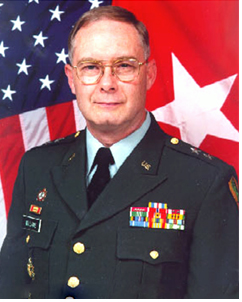Major General
Norman E. Williams
 Norman E. Williams
was born in Washington DC in 1942 and commissioned through ROTC at Loyola College in 1964. After graduation
from the Ordnance Officer Basic Course, he served in Germany as Supply Officer, Shop Officer, and Commander
of both D Company as well as Company A and Headquarters Company, 724th Maintenance Battalion. Following
company command, he was assigned to the Major Items Branch of the US Military Assistance Command in Vietnam,
where he restructured all Army of Vietnam units to reflect modernized equipment and developed the concept of
Mobile Maintenance and Supply Teams to train them.
Norman E. Williams
was born in Washington DC in 1942 and commissioned through ROTC at Loyola College in 1964. After graduation
from the Ordnance Officer Basic Course, he served in Germany as Supply Officer, Shop Officer, and Commander
of both D Company as well as Company A and Headquarters Company, 724th Maintenance Battalion. Following
company command, he was assigned to the Major Items Branch of the US Military Assistance Command in Vietnam,
where he restructured all Army of Vietnam units to reflect modernized equipment and developed the concept of
Mobile Maintenance and Supply Teams to train them.
From 1970 to 1973, Williams served first as a tactical officer for new lieutenants and then as an Instructor in Maintenance Management at the Ordnance Center and School, Aberdeen Proving Ground. Upon graduating from the US Army Command and General Staff College in 1976, he was assigned as Maintenance Staff Officer at the Army Logistics Evaluation Agency, where he rewrote the outdated Army regulation on maintenance policy and saved millions of dollars with the first "War on Batteries" program. In 1979-1980, he served as both the Materiel Officer and Executive Officer of the 194th Maintenance Battalion in Korea. From 1981 to 1983, he commanded the 801st Maintenance Battalion, 101st Airborne Division and was instrumental in helping the Division achieve its best maintenance posture in 21 years.
After graduating from the Army War College in 1984, Williams served as Chief of the Concept and Studies Branch at the Ordnance Center and School. He restructured the non-divisional and general support maintenance companies, wrote the requirements documents for the new Armored Maintenance and Recovery Vehicles, and developed the Master Diagnostician Program.
From 1987 to 1989, Williams commanded the 4th Combat Service Support Training Brigade at Fort Jackson, South Carolina, where he initiated the Platoon Training Concept and implemented the Whole Soldier Training Concept, giving the Training Battalion Commander responsibility for the development of both military and technical skills.
In 1989, Williams was assigned as the Deputy Commander for Combat Developments at the Combined Arms Support Command at Fort Lee, Virginia and played a key role in the transition to multifunctional combat service support battalions, funding the Palletized Load System, and developing support concepts for Air-Land Battle future. In 1991, he became the first Ordnance officer to command the Army and Air Force Exchange System in Europe.
From 1992 to 1993, Williams served as Director of Plans and Operations in the Office of the Deputy Chief of Staff for Logistics (ODCSLOG). In 1993, he took command of the United Nations Logistics Forces in Somalia and assumed responsibility for commanding troops from seven nations. Following command, he returned to ODCSLOG to become the first Director of Transportation, Energy, and Troop Support.
From 1994 to 1997, as Director of Logistics and Security Assistance for US Central Command, he provided oversight of the Department of Defense's largest foreign military sales and assistance program, improved the status of pre-positioned materiel in Southwest Asia, and conducted the no-notice, force-protection relocation of over 5,000 personnel following the Kobar Towers bombing in Saudi Arabia.
Williams culminated his military career as the Chief of Staff at the Army Materiel Command in Alexandria, Virginia, where he led a team that disposed of $495 million in excess and obsolete depot stock and was instrumental in managing the Revolution in Military Logistics.
MG Williams retired in 1999 after 34 years of distinguished service to the Army and the Ordnance Corps.